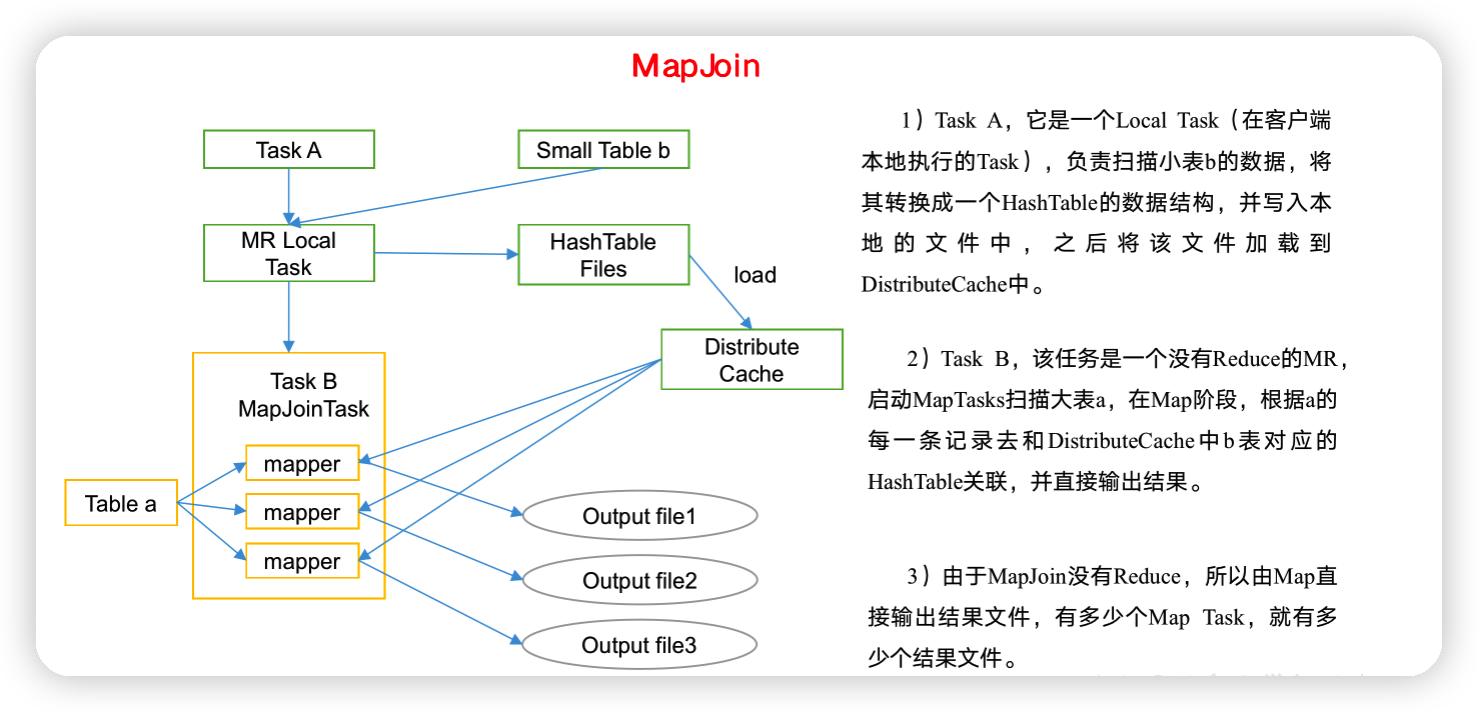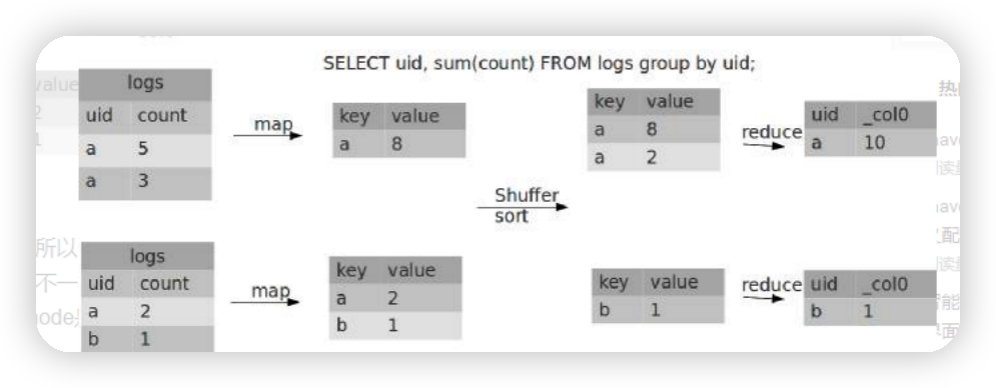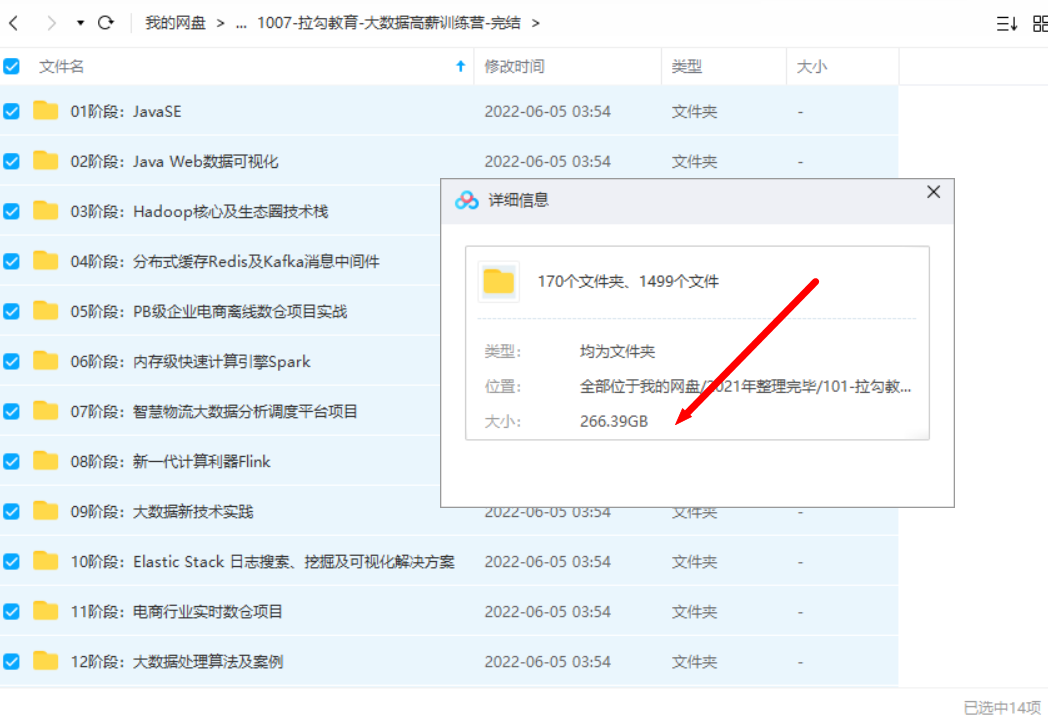标签:bigtable 10 string default hive 企业级 Hive id select
第10章 企业级调优
10.1 执行计划(Explain)
1)基本语法
EXPLAIN [EXTENDED | DEPENDENCY | AUTHORIZATION] query
2)案例实操
(1)查看下面这条语句的执行计划
没有生成MR任务的
hive (default)> explain select * from emp;
Explain
STAGE DEPENDENCIES:
Stage-0 is a root stage
STAGE PLANS:
Stage: Stage-0
Fetch Operator
limit: -1
Processor Tree:
TableScan
alias: emp
Statistics: Num rows: 1 Data size: 7020 Basic stats: COMPLETE Column stats: NONE
Select Operator
expressions: empno (type: int), ename (type: string), job (type: string), mgr (type: int), hiredate (type: string), sal (type: double), comm (type: double), deptno (type: int)
outputColumnNames: _col0, _col1, _col2, _col3, _col4, _col5, _col6, _col7
Statistics: Num rows: 1 Data size: 7020 Basic stats: COMPLETE Column stats: NONE
ListSink
有生成MR任务的
hive (default)> explain select deptno, avg(sal) avg_sal from emp group by deptno;
Explain
STAGE DEPENDENCIES:
Stage-1 is a root stage
Stage-0 depends on stages: Stage-1
STAGE PLANS:
Stage: Stage-1
Map Reduce
Map Operator Tree:
TableScan
alias: emp
Statistics: Num rows: 1 Data size: 7020 Basic stats: COMPLETE Column stats: NONE
Select Operator
expressions: sal (type: double), deptno (type: int)
outputColumnNames: sal, deptno
Statistics: Num rows: 1 Data size: 7020 Basic stats: COMPLETE Column stats: NONE
Group By Operator
aggregations: sum(sal), count(sal)
keys: deptno (type: int)
mode: hash
outputColumnNames: _col0, _col1, _col2
Statistics: Num rows: 1 Data size: 7020 Basic stats: COMPLETE Column stats: NONE
Reduce Output Operator
key expressions: _col0 (type: int)
sort order: +
Map-reduce partition columns: _col0 (type: int)
Statistics: Num rows: 1 Data size: 7020 Basic stats: COMPLETE Column stats: NONE
value expressions: _col1 (type: double), _col2 (type: bigint)
Execution mode: vectorized
Reduce Operator Tree:
Group By Operator
aggregations: sum(VALUE._col0), count(VALUE._col1)
keys: KEY._col0 (type: int)
mode: mergepartial
outputColumnNames: _col0, _col1, _col2
Statistics: Num rows: 1 Data size: 7020 Basic stats: COMPLETE Column stats: NONE
Select Operator
expressions: _col0 (type: int), (_col1 / _col2) (type: double)
outputColumnNames: _col0, _col1
Statistics: Num rows: 1 Data size: 7020 Basic stats: COMPLETE Column stats: NONE
File Output Operator
compressed: false
Statistics: Num rows: 1 Data size: 7020 Basic stats: COMPLETE Column stats: NONE
table:
input format: org.apache.hadoop.mapred.SequenceFileInputFormat
output format: org.apache.hadoop.hive.ql.io.HiveSequenceFileOutputFormat
serde: org.apache.hadoop.hive.serde2.lazy.LazySimpleSerDe
Stage: Stage-0
Fetch Operator
limit: -1
Processor Tree:
ListSink
(2)查看详细执行计划
hive (default)> explain extended select * from emp;
hive (default)> explain extended select deptno, avg(sal) avg_sal from emp group by deptno;
10.2 Fetch抓取
Fetch抓取是指,Hive中对某些情况的查询可以不必使用MapReduce计算。例如:SELECT * FROM employees;在这种情况下,Hive可以简单地读取employee对应的存储目录下的文件,然后输出查询结果到控制台。
在hive-default.xml.template文件中hive.fetch.task.conversion默认是more,老版本hive默认是minimal,该属性修改为more以后,在全局查找、字段查找、limit查找等都不走mapreduce。
<property>
<name>hive.fetch.task.conversion</name>
<value>more</value>
<description>
Expects one of [none, minimal, more].
Some select queries can be converted to single FETCH task minimizing latency.
Currently the query should be single sourced not having any subquery and should not have any aggregations or distincts (which incurs RS), lateral views and joins.
0. none : disable hive.fetch.task.conversion
1. minimal : SELECT STAR, FILTER on partition columns, LIMIT only
2. more : SELECT, FILTER, LIMIT only (support TABLESAMPLE and virtual columns)
</description>
</property>
1)案例实操:
(1)把hive.fetch.task.conversion设置成none,然后执行查询语句,都会执行mapreduce程序。
hive (default)> set hive.fetch.task.conversion=none;
hive (default)> select * from emp;
hive (default)> select ename from emp;
hive (default)> select ename from emp limit 3;
(2)把hive.fetch.task.conversion设置成more,然后执行查询语句,如下查询方式都不会执行mapreduce程序。
hive (default)> set hive.fetch.task.conversion=more;
hive (default)> select * from emp;
hive (default)> select ename from emp;
hive (default)> select ename from emp limit 3;
10.3 本地模式
大多数的Hadoop Job是需要Hadoop提供的完整的可扩展性来处理大数据集的。不过,有时Hive的输入数据量是非常小的。在这种情况下,为查询触发执行任务消耗的时间可能会比实际job的执行时间要多的多。
对于大多数这种情况,Hive可以通过本地模式在单台机器上处理所有的任务。对于小数据集,执行时间可以明显被缩短。
用户可以通过设置hive.exec.mode.local.auto的值为true,来让Hive在适当的时候自动启动这个优化。
set hive.exec.mode.local.auto=true; //开启本地mr
//设置local mr的最大输入数据量,当输入数据量小于这个值时采用local mr的方式,默认为134217728,即128M
set hive.exec.mode.local.auto.inputbytes.max=50000000;
//设置local mr的最大输入文件个数,当输入文件个数小于这个值时采用local mr的方式,默认为4
set hive.exec.mode.local.auto.input.files.max=10;
1)案例实操:
(1)开启本地模式,并执行查询语句
hive (default)> set hive.exec.mode.local.auto=true;
hive (default)> select * from emp cluster by deptno;
Time taken: 1.328 seconds, Fetched: 14 row(s)
(2)关闭本地模式,并执行查询语句
hive (default)> set hive.exec.mode.local.auto=false;
hive (default)> select * from emp cluster by deptno;
Time taken: 20.09 seconds, Fetched: 14 row(s)
10.4 表的优化
10.4.1 小表大表Join(MapJoin)
将key相对分散,并且数据量小的表放在join的左边,这样可以有效减少内存溢出错误发生的几率;再进一步,可以使用map join让小的维度表(1000条以下的记录条数)先进内存。在map端完成join。
实际测试发现:新版的hive已经对小表JOIN大表和大表JOIN小表进行了优化。小表放在左边和右边已经没有明显区别。
案例实操
1)需求
测试大表JOIN小表和小表JOIN大表的效率
2)开启MapJoin参数设置
(1)设置自动选择Mapjoin
set hive.auto.convert.join = true; 默认为true
(2)大表小表的阈值设置(默认25M以下认为是小表):
set hive.mapjoin.smalltable.filesize = 25000000;
3)MapJoin工作机制

4)建大表、小表和JOIN后表的语句
// 创建大表
create table bigtable(id bigint, t bigint, uid string, keyword string, url_rank int, click_num int, click_url string) row format delimited fields terminated by '\t';
// 创建小表
create table smalltable(id bigint, t bigint, uid string, keyword string, url_rank int, click_num int, click_url string) row format delimited fields terminated by '\t';
// 创建join后表的语句
create table jointable(id bigint, t bigint, uid string, keyword string, url_rank int, click_num int, click_url string) row format delimited fields terminated by '\t';
5)分别向大表和小表中导入数据
hive (default)> load data local inpath '/opt/module/hive/datas/bigtable' into table bigtable;
hive (default)>load data local inpath '/opt/module/hive/datas/smalltable' into table smalltable;
6)小表JOIN大表语句
insert overwrite table jointable
select b.id, b.t, b.uid, b.keyword, b.url_rank, b.click_num, b.click_url
from smalltable s
join bigtable b
on b.id = s.id;
Time taken: 35.921 seconds
No rows affected (44.456 seconds)
7)执行大表JOIN小表语句
insert overwrite table jointable
select b.id, b.t, b.uid, b.keyword, b.url_rank, b.click_num, b.click_url
from bigtable b
join smalltable s
on s.id = b.id;
Time taken: 34.196 seconds
No rows affected (26.287 seconds)
10.4.2 大表Join大表
1)空KEY过滤
有时join超时是因为某些key对应的数据太多,而相同key对应的数据都会发送到相同的reducer上,从而导致内存不够。此时我们应该仔细分析这些异常的key,很多情况下,这些key对应的数据是异常数据,我们需要在SQL语句中进行过滤。例如key对应的字段为空,操作如下:
案例实操
(1)配置历史服务器
配置mapred-site.xml
<property>
<name>mapreduce.jobhistory.address</name>
<value>hadoop102:10020</value>
</property>
<property>
<name>mapreduce.jobhistory.webapp.address</name>
<value>hadoop102:19888</value>
</property>
启动历史服务器
sbin/mr-jobhistory-daemon.sh start historyserver
查看jobhistory
http://hadoop102:19888/jobhistory
(2)创建原始数据表、空id表、合并后数据表
// 创建空id表
create table nullidtable(id bigint, t bigint, uid string, keyword string, url_rank int, click_num int, click_url string) row format delimited fields terminated by '\t';
(3)分别加载原始数据和空id数据到对应表中
hive (default)> load data local inpath '/opt/module/hive/datas/nullid' into table nullidtable;
(4)测试不过滤空id
hive (default)> insert overwrite table jointable select n.* from nullidtable n
left join bigtable o on n.id = o.id;
(5)测试过滤空id
hive (default)> insert overwrite table jointable select n.* from (select * from nullidtable where id is not null ) n left join bigtable o on n.id = o.id;
2)空key转换
有时虽然某个key为空对应的数据很多,但是相应的数据不是异常数据,必须要包含在join的结果中,此时我们可以表a中key为空的字段赋一个随机的值,使得数据随机均匀地分不到不同的reducer上。例如:
案例实操:
不随机分布空null值:
(1)设置5个reduce个数
set mapreduce.job.reduces = 5;
(2)JOIN两张表
insert overwrite table jointable
select n.* from nullidtable n left join bigtable b on n.id = b.id;
结果:如下图所示,可以看出来,出现了数据倾斜,某些reducer的资源消耗远大于其他reducer。
随机分布空null值
(1)设置5个reduce个数
set mapreduce.job.reduces = 5;
(2)JOIN两张表
insert overwrite table jointable
select n.* from nullidtable n full join bigtable o on
nvl(n.id,rand()) = o.id;
结果:如下图所示,可以看出来,消除了数据倾斜,负载均衡reducer的资源消耗
3)SMB(Sort Merge Bucket join)
(1)创建第二张大表
create table bigtable2(
id bigint,
t bigint,
uid string,
keyword string,
url_rank int,
click_num int,
click_url string)
row format delimited fields terminated by '\t';
load data local inpath '/opt/module/data/bigtable' into table bigtable2;
测试大表直接JOIN
insert overwrite table jointable
select b.id, b.t, b.uid, b.keyword, b.url_rank, b.click_num, b.click_url
from bigtable s
join bigtable2 b
on b.id = s.id;
(2)创建分桶表1,桶的个数不要超过可用CPU的核数
create table bigtable_buck1(
id bigint,
t bigint,
uid string,
keyword string,
url_rank int,
click_num int,
click_url string)
clustered by(id)
sorted by(id)
into 6 buckets
row format delimited fields terminated by '\t';
insert into bigtable_buck1 select * from bigtable;
(3)创建分通表2,桶的个数不要超过可用CPU的核数
create table bigtable_buck2(
id bigint,
t bigint,
uid string,
keyword string,
url_rank int,
click_num int,
click_url string)
clustered by(id)
sorted by(id)
into 6 buckets
row format delimited fields terminated by '\t';
insert into bigtable_buck2 select * from bigtable;
(4)设置参数
set hive.optimize.bucketmapjoin = true;
set hive.optimize.bucketmapjoin.sortedmerge = true;
set hive.input.format=org.apache.hadoop.hive.ql.io.BucketizedHiveInputFormat;
(5)测试
insert overwrite table jointable
select b.id, b.t, b.uid, b.keyword, b.url_rank, b.click_num, b.click_url
from bigtable_buck1 s
join bigtable_buck2 b
on b.id = s.id;
10.4.3 Group By
默认情况下,Map阶段同一Key数据分发给一个reduce,当一个key数据过大时就倾斜了。

并不是所有的聚合操作都需要在Reduce端完成,很多聚合操作都可以先在Map端进行部分聚合,最后在Reduce端得出最终结果。
1)开启Map端聚合参数设置
(1)是否在Map端进行聚合,默认为True
set hive.map.aggr = true
(2)在Map端进行聚合操作的条目数目
set hive.groupby.mapaggr.checkinterval = 100000
(3)有数据倾斜的时候进行负载均衡(默认是false)
set hive.groupby.skewindata = true
当选项设定为 true,生成的查询计划会有两个MR Job。第一个MR Job中,Map的输出结果会随机分布到Reduce中,每个Reduce做部分聚合操作,并输出结果,这样处理的结果是相同的Group By Key有可能被分发到不同的Reduce中,从而达到负载均衡的目的;第二个MR Job再根据预处理的数据结果按照Group By Key分布到Reduce中(这个过程可以保证相同的Group By Key被分布到同一个Reduce中),最后完成最终的聚合操作。
hive (default)> select deptno from emp group by deptno;
Stage-Stage-1: Map: 1 Reduce: 5 Cumulative CPU: 23.68 sec HDFS Read: 19987 HDFS Write: 9 SUCCESS
Total MapReduce CPU Time Spent: 23 seconds 680 msec
OK
deptno
10
20
30
优化以后
hive (default)> set hive.groupby.skewindata = true;
hive (default)> select deptno from emp group by deptno;
Stage-Stage-1: Map: 1 Reduce: 5 Cumulative CPU: 28.53 sec HDFS Read: 18209 HDFS Write: 534 SUCCESS
Stage-Stage-2: Map: 1 Reduce: 5 Cumulative CPU: 38.32 sec HDFS Read: 15014 HDFS Write: 9 SUCCESS
Total MapReduce CPU Time Spent: 1 minutes 6 seconds 850 msec
OK
deptno
10
20
30
10.4.4 Count(Distinct) 去重统计
数据量小的时候无所谓,数据量大的情况下,由于COUNT DISTINCT操作需要用一个Reduce Task来完成,这一个Reduce需要处理的数据量太大,就会导致整个Job很难完成,一般COUNT DISTINCT使用先GROUP BY再COUNT的方式替换,但是需要注意group by造成的数据倾斜问题.
1) 案例实操
(1)创建一张大表
hive (default)> create table bigtable(id bigint, time bigint, uid string, keyword
string, url_rank int, click_num int, click_url string) row format delimited
fields terminated by '\t';
(2)加载数据
hive (default)> load data local inpath '/opt/module/datas/bigtable' into table bigtable;
(3)设置5个reduce个数
set mapreduce.job.reduces = 5;
(4)执行去重id查询
hive (default)> select count(distinct id) from bigtable;
Stage-Stage-1: Map: 1 Reduce: 1 Cumulative CPU: 7.12 sec HDFS Read: 120741990 HDFS Write: 7 SUCCESS
Total MapReduce CPU Time Spent: 7 seconds 120 msec
OK
c0
100001
Time taken: 23.607 seconds, Fetched: 1 row(s)
(5)采用GROUP by去重id
hive (default)> select count(id) from (select id from bigtable group by id) a;
Stage-Stage-1: Map: 1 Reduce: 5 Cumulative CPU: 17.53 sec HDFS Read: 120752703 HDFS Write: 580 SUCCESS
Stage-Stage-2: Map: 1 Reduce: 1 Cumulative CPU: 4.29 sec2 HDFS Read: 9409 HDFS Write: 7 SUCCESS
Total MapReduce CPU Time Spent: 21 seconds 820 msec
OK
_c0
100001
Time taken: 50.795 seconds, Fetched: 1 row(s)
虽然会多用一个Job来完成,但在数据量大的情况下,这个绝对是值得的。
10.4.5 笛卡尔积
尽量避免笛卡尔积,join的时候不加on条件,或者无效的on条件,Hive只能使用1个reducer来完成笛卡尔积。
10.4.6 行列过滤
列处理:在SELECT中,只拿需要的列,如果有分区,尽量使用分区过滤,少用SELECT *。
行处理:在分区剪裁中,当使用外关联时,如果将副表的过滤条件写在Where后面,那么就会先全表关联,之后再过滤,比如:
案例实操:
1)测试先关联两张表,再用where条件过滤
hive (default)> select o.id from bigtable b
join bigtable o.id = b.id
where o.id <= 10;
Time taken: 34.406 seconds, Fetched: 100 row(s)
2)通过子查询后,再关联表
hive (default)> select b.id from bigtable b
join (select id from bigtable where id <= 10 ) o on b.id = o.id;
Time taken: 30.058 seconds, Fetched: 100 row(s)
10.4.7 分区
详见7.1章。
10.4.8 分桶
详见7.2章。
10.5 合理设置Map及Reduce数
1)通常情况下,作业会通过input的目录产生一个或者多个map任务。
主要的决定因素有:input的文件总个数,input的文件大小,集群设置的文件块大小。
2)是不是map数越多越好?
答案是否定的。如果一个任务有很多小文件(远远小于块大小128m),则每个小文件也会被当做一个块,用一个map任务来完成,而一个map任务启动和初始化的时间远远大于逻辑处理的时间,就会造成很大的资源浪费。而且,同时可执行的map数是受限的。
3)是不是保证每个map处理接近128m的文件块,就高枕无忧了?
答案也是不一定。比如有一个127m的文件,正常会用一个map去完成,但这个文件只有一个或者两个小字段,却有几千万的记录,如果map处理的逻辑比较复杂,用一个map任务去做,肯定也比较耗时。
针对上面的问题2和3,我们需要采取两种方式来解决:即减少map数和增加map数;
10.5.1 复杂文件增加Map数
当input的文件都很大,任务逻辑复杂,map执行非常慢的时候,可以考虑增加Map数,来使得每个map处理的数据量减少,从而提高任务的执行效率。
增加map的方法为:根据
computeSliteSize(Math.max(minSize,Math.min(maxSize,blocksize)))=blocksize=128M公式,调整maxSize最大值。让maxSize最大值低于blocksize就可以增加map的个数。
案例实操:
1)执行查询
hive (default)> select count(*) from emp;
Hadoop job information for Stage-1: number of mappers: 1; number of reducers: 1
2)设置最大切片值为100个字节
hive (default)> set mapreduce.input.fileinputformat.split.maxsize=100;
hive (default)> select count(*) from emp;
Hadoop job information for Stage-1: number of mappers: 6; number of reducers: 1
10.5.2 小文件进行合并
1)在map执行前合并小文件,减少map数:CombineHiveInputFormat具有对小文件进行合并的功能(系统默认的格式)。HiveInputFormat没有对小文件合并功能。
set hive.input.format= org.apache.hadoop.hive.ql.io.CombineHiveInputFormat;
2)在Map-Reduce的任务结束时合并小文件的设置:
在map-only任务结束时合并小文件,默认true
SET hive.merge.mapfiles = true;
在map-reduce任务结束时合并小文件,默认false
SET hive.merge.mapredfiles = true;
合并文件的大小,默认256M
SET hive.merge.size.per.task = 268435456;
当输出文件的平均大小小于该值时,启动一个独立的map-reduce任务进行文件merge
SET hive.merge.smallfiles.avgsize = 16777216;
10.5.3 合理设置Reduce数
1)调整reduce个数方法一
(1)每个Reduce处理的数据量默认是256MB
hive.exec.reducers.bytes.per.reducer=256000000
(2)每个任务最大的reduce数,默认为1009
hive.exec.reducers.max=1009
(3)计算reducer数的公式
N=min(参数2,总输入数据量/参数1)
2)调整reduce个数方法二
在hadoop的mapred-default.xml文件中修改
设置每个job的Reduce个数
set mapreduce.job.reduces = 15;
3)reduce个数并不是越多越好
- 过多的启动和初始化reduce也会消耗时间和资源;
- 另外,有多少个reduce,就会有多少个输出文件,如果生成了很多个小文件,那么如果这些小文件作为下一个任务的输入,则也会出现小文件过多的问题;
在设置reduce个数的时候也需要考虑这两个原则:处理大数据量利用合适的reduce数;使单个reduce任务处理数据量大小要合适;
10.6 并行执行
Hive会将一个查询转化成一个或者多个阶段。这样的阶段可以是MapReduce阶段、抽样阶段、合并阶段、limit阶段。或者Hive执行过程中可能需要的其他阶段。默认情况下,Hive一次只会执行一个阶段。不过,某个特定的job可能包含众多的阶段,而这些阶段可能并非完全互相依赖的,也就是说有些阶段是可以并行执行的,这样可能使得整个job的执行时间缩短。不过,如果有更多的阶段可以并行执行,那么job可能就越快完成。
通过设置参数hive.exec.parallel值为true,就可以开启并发执行。不过,在共享集群中,需要注意下,如果job中并行阶段增多,那么集群利用率就会增加。
set hive.exec.parallel=true; //打开任务并行执行
set hive.exec.parallel.thread.number=16; //同一个sql允许最大并行度,默认为8。
当然,得是在系统资源比较空闲的时候才有优势,否则,没资源,并行也起不来。
10.7 严格模式
Hive可以通过设置防止一些危险操作:
1)分区表不使用分区过滤
将hive.strict.checks.no.partition.filter设置为true时,对于分区表,除非where语句中含有分区字段过滤条件来限制范围,否则不允许执行。换句话说,就是用户不允许扫描所有分区。进行这个限制的原因是,通常分区表都拥有非常大的数据集,而且数据增加迅速。没有进行分区限制的查询可能会消耗令人不可接受的巨大资源来处理这个表。
2)使用order by没有limit过滤
将hive.strict.checks.orderby.no.limit设置为true时,对于使用了order by语句的查询,要求必须使用limit语句。因为order by为了执行排序过程会将所有的结果数据分发到同一个Reducer中进行处理,强制要求用户增加这个LIMIT语句可以防止Reducer额外执行很长一段时间。
3)笛卡尔积
将hive.strict.checks.cartesian.product设置为true时,会限制笛卡尔积的查询。对关系型数据库非常了解的用户可能期望在 执行JOIN查询的时候不使用ON语句而是使用where语句,这样关系数据库的执行优化器就可以高效地将WHERE语句转化成那个ON语句。不幸的是,Hive并不会执行这种优化,因此,如果表足够大,那么这个查询就会出现不可控的情况。
10.8 JVM重用
详见hadoop优化文档中jvm重用
10.9 压缩
详见第9章。
IT学习网站
大数据高薪训练营 完结

链接:https://pan.baidu.com/s/1ssRD-BYOiiMw30EV_BLMWQ
提取码:dghu
失效加V:x923713
QQ交流群 欢迎加入

标签:bigtable,10,string,default,hive,企业级,Hive,id,select 来源: https://www.cnblogs.com/niuniu2022/p/16354085.html
本站声明: 1. iCode9 技术分享网(下文简称本站)提供的所有内容,仅供技术学习、探讨和分享; 2. 关于本站的所有留言、评论、转载及引用,纯属内容发起人的个人观点,与本站观点和立场无关; 3. 关于本站的所有言论和文字,纯属内容发起人的个人观点,与本站观点和立场无关; 4. 本站文章均是网友提供,不完全保证技术分享内容的完整性、准确性、时效性、风险性和版权归属;如您发现该文章侵犯了您的权益,可联系我们第一时间进行删除; 5. 本站为非盈利性的个人网站,所有内容不会用来进行牟利,也不会利用任何形式的广告来间接获益,纯粹是为了广大技术爱好者提供技术内容和技术思想的分享性交流网站。
